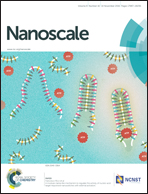Nano-mechanical single-cell sensing of cell–matrix contacts†
Abstract
Extracellular protein matrices provide a rigidity interface exhibiting nano-mechanical cues that guide cell growth and proliferation. Cells sense such cues using actin-rich filopodia extensions which encourage favourable cell–matrix contacts to recruit more actin-mediated local forces into forming stable focal adhesions. A challenge remains in identifying and measuring these local cellular forces and in establishing empirical relationships between them, cell adhesion and filopodia formation. Here we investigate such relationships using a micromanipulation system designed to operate at the time scale of focal contact dynamics, with the sample frequency of a force probe being 0.1 ms, and to apply and measure forces at nano-to-micro Newton ranges for individual mammalian cells. We explore correlations between cell biomechanics, cell–matrix attachment forces and the spread areas of adhered cells as well as their relative dependence on filopodia formation using synthetic protein matrices with a proven ability to induce enhanced filopodia numbers in adherent cells. This study offers a basis for engineering exploitable cell–matrix contacts in situ at the nanoscale and single-cell levels.


 Please wait while we load your content...
Please wait while we load your content...